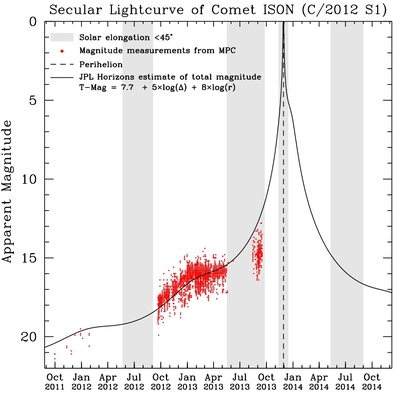Comet ISONs Current Status
We will update this plot from time-to-time, but keep in mind that observations become sparse when the comet is at solar elongations less than ~45-degrees (meaning it is in the region of the sky close to the Sun). We've indicated this on the plot with the dark gray vertical bars. As we get closer to perihelion, we will update it more frequently as more data become available.
You will notice that the peak of this plot is not shown. Why? Because it's meaningless right now! The CIOC Team believe that ISON's peak brightness (which will occur in the few hours surrounding perihelion) could be anywhere from magnitude -7 to +5 or more, though our current educated guesses are hovering around -3 to -5.
Certainly if you browse around online you will find references to estimates of magnitude -10 or even -15, and the term "Comet of the Century" has been tossed around with abandon. Those are not the words of the CIOC Team, and while they may perhaps turn out to be true, we think it highly unlikely. More likely, ISON will be one of the brightest comets in the past several years and, thanks to the global astronomy community, we hope one of the most broadly observed comets in history!
Right now, Comet ISON is still far from Earth and the Sun, and not tremendously brighter than when it was first discovered, with a brightness of around magnitude 14 at time of writing. This is largely as expected, as the rate at which a comet brightens will increase the closer it gets to the Sun (more on this later) when more of its volatile materials start outgassing and vaporizing, although we would have liked to have seen a bit more of an uptick in brightness by now. But comets are nothing if not unpredictable, and simply by looking at its brightness evolution, we can compare Comet ISON to all other comets we have on record and make inferences about its current behavior, and use those to predict its future behavior.
But there is more to studying comets than just looking at how bright they are, and much of our present analysis of Comet ISON is focussed on looking at how big it is (a few kilometers, it seems) and how much dust it is producing (above average), the latter being a useful predictor for how it might behave when it reaches the inner solar system later this year. In particular, there’s a scientific parameter we call “Afrho”, which roughly speaking is a measure of how much dust a comet is producing. There are well-established procedures for measuring this parameter on astronomical images, and it’s something that many professional astronomers often do, and indeed have done for Comet ISON.
So what have they found? Well, right now the Afrho parameter indicates that ISON is somewhat more active than a “typical” comet, and is producing quite a lot of very fine dust. However, to give an example, it is certainly not as active as the beautiful comet Hale-Bopp was when it was at an equivalent distance from the Sun. What does this tell us? Well, we know that to even be visible at over 6AU, and to be producing dust at the rate it is, Comet ISON must be at least a reasonably large comet, as dust production is proportional to the size of the comet. The only alternative explanation would be that ISON has been undergoing what we call an “outburst” of activity.
However, we can rule this possibility out because we have approximately 12-months of ISON images now, and its brightness has remained more-or-less constant in that time (outbursts are generally quite short-lived).
So we know it’s moderately big, and we know it’s quite active, but we also are fairly sure it’s not “huge” like Hale-Bopp was, which had a nucleus on the order of 30km or so. What does that tell us about its future? Read on!
